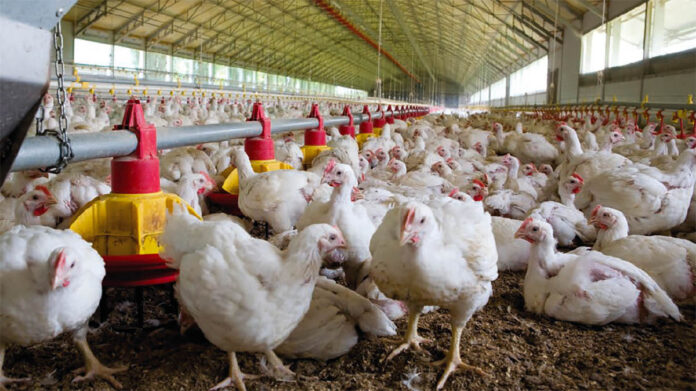
In recent years, humic substances have been tested as growth promoters in animal production and are one of the promising options to face the globally ban of antibiotics in feeds. The objective of the study was to evaluate the productive parameters, carcass yield, histopathology and microbiology of the small intestine and liver in broilers fed diets added with an extract of humic substances (EHS) and with low and high fiber content (LF and HF).
Introduction
In veterinary medicine, humic substances (HS) have been used as antidiarrheal agents, pain relievers, immunomodulators and antimicrobials, after the recommendations of the Veterinary Committee of the European Medicine Agency for the Evaluation of Medicinal Products (EMEA, 1999). Humic substances are part of humus-soil organic matter, and are compounds arising from the physical, chemical and microbiological transformation (humification) of biomolecules. Approximately 80% of the total carbon in terrestrial media and 60% of the carbon dissolved in aquatic media are made up of HS; hence they are a complex mixture of many different acids containing carboxyl and phenolate groups.
In broiler chickens and laying hens, growth-promoting effects of HS when supplemented in the feeds or drinking water have been documented. In broiler chickens, improvements in body weight, feed conversion, ash content of the tibia, ash retention and digestibility, as well as reduction in crypt depth and increased length of the villi of the jejunal mucosa due to the inclusion of HS have been reported. Most of the HS tested in poultry are commercially available or purified products. It is well known that wormcomposts originating from animal manures are also good sources of HS.
In a previous study, it was found that the addition of an extract of HS (EHS) from a worm compost reduced the mucosal permeability and the bacterial translocation to the liver of broiler chickens experiencing feed restriction; the feed restriction model was used to cause intestinal inflammation. These responses were not observed in non-challenged broilers or under in vitro conditions. One of the proposed mechanisms of action of HS is related to their ability to create protective layers over the epithelial mucosal membrane of the digestive tract against toxic and bacterial contaminated substances. Whether this mechanism is involved in the enhanced growth through the reduction of the microbial load and lesion scores in broilers added with HS is unknown. The objective of this study was to evaluate the productive parameters, carcass yield, histopathology and microbiology of the small intestine and liver of broilers fed with low fiber (LF) content and high fiber (HF) content diets and added with an EHS.
Materials and methods
The isolation and extraction of the EHS from worm compost was performed as described by Maguey-Gonzalez et al. in 2018. A group of 240 Ross 308 male broilers were allocated in holding cages (30 cm wide x 38 cm deep x 37 cm height) providing 1140 cm2/bird from 21 to 42 d of age. Cages were arranged in batteries and were provided with gas heaters, equipped with a plastic feeder and a cup waterer.
Birds were randomly assigned to three treatments: PC) Positive control added with bacitracin methylene disalicylate as antibiotic growth promoter (AGP) and salinomycin as anticoccidial drug (AC); NC) Negative control without AGP and AC drug; EHS) Same as NC) but added with 0.5% of EHS, and two set of diets with low and high fiber content (LF and HF). The LF diet was formulated with corn and soybean meal and the HF was formulated with corn, soybean meal, distillers dried grain with solubles and wheat bran. Feed and water were offered ad libitum throughout the experiment. Broilers were weighed at the beginning and end of the trial to calculate the daily weight gain (WG, g/d). Feed offered and refused was registered to calculate the daily feed intake (FI, g/d). The feed conversion ratio (FCR) was estimated by dividing the FI between the WG. At the end of the trial, all broilers were killed and the carcass and breast were weighed.
For measurement of microbiota, digesta from the jejunum and ceca were taken as well as liver samples from six broilers per treatment. The total mesophilic bacteria (TMB) were determined using the standard plate count method. Counts of viable E. coli in the samples were conducted by plating serial 10-fold dilutions onto MacConkey agar plates. Counts of viable Lactobacillus (LAC) in the jejunum samples were also conducted using lactobacilli medium III agar plates. The E. coli and LAC plates were incubated for 24 h, both under aerobic conditions. Colonies on each agar plate were expressed as colony-forming units per gram (log10 CFU/g). In the jejunum samples, the total fungi and yeast were also cultured on Sabouraud glucose agar with chloramphenicol and incubated at 37 °C for 48 h.
One-cm samples from the duodenum, lower jejunum and liver were taken from six broilers per treatment for histopathologic evaluations; the tissues were stained and the histopathological changes were observed under light microscope by an experienced avian veterinarian who was blind to treatment allocations. Based upon severity of the lesions, a score of 0 (no lesions), 1 (mild lesions), 2 (moderate lesions), 3 (severe lesions) or 4 (extremely severe lesions) were recorded for each chicken. The total number of lesion scores were recorded per each tissue per treatment. Additionally, the severity of lesion, from 0 to 4, was calculated as the sum of lesion scores in the three tissues (duodenum, jejunum, and liver).
The results were subjected to ANOVA. The number of lesions and severity of lesion scores were transformed to log10 before the analysis.
Results and discussion
The FI was higher (P<0.05) in NC- and EHS-fed broilers compared to broilers fed the PC diet.
The higher FI in EHS-fed broilers do not agree with previous results in which no effect or reductions on the FI have been reported in broiler chickens fed different products containing HS. In EHS-fed broilers receiving a LF diet, the lowest FCR was observed, which closely resembles the lower FCR reported by other authors when HS were supplemented either in the feeds or in the drinking water of broiler chickens. On the other hand, EHS-fed broilers assigned to a HF diet showed higher FCR, which could be attributed to the higher intake of NSPs, which increases digesta viscosity and reduces the dietary digestibility contributing to undesirable fermentations in the intestine. This effect was probably aggravated due to the colloidal properties and the ability of HS to form aggregates within solutions.
The TMB and E. coli counts were lower (P<0.01) in the jejunum and ceca of PC broilers compared to NC and EHS-fed broilers; the TMB and E. coli in jejunum and ceca were similar between NC and EHS broilers. These results do not agree with previous reports based on in vitro and in vivo assays in which different sources of HS showed antimicrobial activity against many human pathogenic bacteria, as well as inhibition of S. aureus, Candida, E. coli and S. Enteritidis. It was also reported that broiler chickens fed diets with HS showed lower E. coli counts in the intestinal content. Opposite to this, the coliforms and E. coli counts in the caecum were not affected in broilers added with humates.
In the liver, the E. coli counts were not different among treatments; but the TMB counts were similar in broilers fed the LF diet, whilst in broilers fed the HF diet the TMB were higher in EHS compared to PC broilers (Interaction of treatment and type of diet, P<0.01). This finding is also opposite to the lower bacterial translocation found in the liver of broilers fed a HS extracted from the same worm compost as the EHS used in the present study. The LAB counts were higher in PC and NC compared to EHS-fed broilers (P<0.05). In previous studies, a lack of response or increased LAC counts were reported in broilers supplemented with HS. The fungi were similar among treatments but the yeast were lower in EHS- compared to NC-fed broilers, while yeast in PC broilers were intermediate.
The number of lesions in duodenum were highest (P<0.05) in broilers receiving the EHS and were lowest in NC broilers, whereas in the jejunum the lesions were highest (P<0.05) in PC broilers and were lowest in EHS-fed broilers. In liver, the number of lesions were higher (P<0.05) in NC broilers compared to PC and EHS-fed broilers; no differences in the lesion number were observed between PC- and EHS-fed broilers.
These findings do not agree with the microbiological analysis in which the PC broilers had reduced TMB and E. coli counts in duodenum, jejunum and liver compared to EHS-fed broilers. The results of the severity of lesion, indicates that there were no statistical differences among treatments in the frequency of score 0, or no lesions, based in the sum of lesion in the duodenum, jejunum, and liver. The frequency of score 1 (mild lesion) was higher (P<0.05) in NC broilers compared to PC and EHS-fed broilers. The frequency of score 2 (moderate lesions) was higher (P<0.05) in EHS-fed broilers compared to PC and NC broilers. The frequency of score 3 (severe lesions) were higher (P<0.05) in PC- compared to NC- and EHS-fed broilers. Score 4, extremely severe lesions, were not detected in any tissue.
One of the proposed mechanisms of action of HS is related to the ability to create protective layers over the epithelial mucosal membrane of the digestive tract against toxic and bacterial contaminated substances; however, the results of the number and severity of lesion do not support this suggestion because the supplementation of the EHS did not reduce the overall lesions compared to the PC and NC groups.
Regarding the diet effect, it was found that the final body weight, FI, WG, and the breast and carcass weight were higher (P<0.05) in LF-fed broilers; however, the TMB and LAB counts, the number of lesions in liver and the frequency of score 3 lesions were higher (P<0.05) in HF-fed broilers. When chickens are fed alternative ingredients such as distillers dried grain with solubles and wheat bran that are high in non-starch polysaccharides (NSPs), poor performance and unmanageable litter conditions caused by sticky droppings are observed. High dietary NSPs increases the digesta viscosity and reduces the digestibility and contributes to undesirable fermentations in the intestine and, hence to higher bacterial counts and bacterial translocation to the liver. Higher digesta viscosity was also reported in broilers fed a source of HS fed a LF diet; from this finding it was expected that broilers on the EHS treatment and fed a HF diet would show impaired growth responses, higher microbiological counts and higher lesion scores in all tissues. This assumption was only supported by the higher TMB counts in the liver of EHS-fed broilers receiving a HF diet.
In summary, the addition of the EHS in broiler chickens fed a LF diet improved the FCR, but did not reduce the counts of TMB and E. coli in jejunum, ceca and liver nor diminish the number and severity of lesion in duodenum, jejunum and liver.
References available on request
From the 68th Western Poultry Disease Conference Proceedings

















